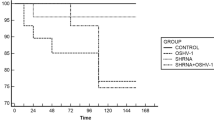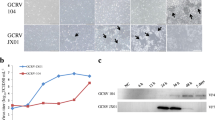Abstract
Spring viremia of carp virus (SVCV) is a highly lethal virus in common carp (Cyprinus carpio) and other cyprinid fish species. The aim of the present study was to develop an in vivo therapeutic measure against SVCV using artificial microRNA (AmiRNA) targeting the SVCV P gene transcript. Three candidates of AmiRNAs (AmiR-P1, -P2, and -P3) were selected, and their ability to downregulate SVCV P gene transcript was analyzed by both synthesized AmiRNA mimics and AmiRNA-expressing vector system, in which AmiR-P3 showed the strongest inhibitory activity among the three candidates. To overcome in vivo limitation of miRNA mimics or plasmid-based miRNA expression systems, we rescued recombinant snakehead rhabdoviruses (SHRVs) expressing SVCV P gene–targeting AmiRNA (rSHRV-AmiR-P3) or control AmiRNA (rSHRV-AmiR-C) using reverse genetic technology. The successful expression of AmiR-P3 and AmiR-C in cells infected with the rescued viruses was verified by quantitative PCR. To evaluate the availability of rSHRV-AmiR-P3 for in vivo control of SVCV, zebrafish (Danio rerio) were (i) infected with either rSHRV-AmiR-C or rSHRV-AmiR-P3 followed by SVCV infection or (ii) infected with SVCV followed by either rSHRV-AmiR-C or rSHRV-AmiR-P3 infection. Fish infected with rSHRVs before and after SVCV infection showed significantly higher survival rates than fish infected with SVCV alone. There was no significant difference in survival rates between groups of fish infected with rSHRV-AmiR-C and rSHRV-AmiR-P3 before SVCV infection; however, fish infected with SVCV followed by infection with rSHRV-AmiR-P3 showed significantly higher survival rates than fish infected with rSHRV-AmiR-C. These results suggest that rSHRV-AmiR-P3 has therapeutic potential against SVCV in fish when administered after SVCV infection, and rSHRVs expressing artificial microRNAs targeting SVCV transcripts could be used as a tool to control SVCV infection in fish for a therapeutic purpose.




Similar content being viewed by others
Availability of Data and Material
The raw data that support the findings of this study and the material described are available from the corresponding author on request.
References
Ahne W, Bjorklund HV, Essbauer S, Fijan N, Kurath G, Winton JR (2002) Spring viremia of carp (SVC). Dis Aquat Org 52:261–272
Alonso M, Kim CH, Johnson MC, Pressley M, Leong JA (2004) The NV gene of snakehead rhabdovirus (SHRV) is not required for pathogenesis, and a heterologous glycoprotein can be incorporated into the SHRV envelope. J Virol 78:5875–5882
Ashraf U, Lu Y, Lin L, Yuan J, Wang M, Liu X (2016) Spring viraemia of carp virus: recent advances. J Gen Virol 97:1037–1051
Davis BN, Hata A (2010) Mechanisms of control of microRNA biogenesis. J Biochem 148:381–392
Diener C, Keller A, Meese E (2022) Emerging concepts of miRNA therapeutics: from cells to clinic. Trends Genet 38:613–626
Filipowicz W, Bhattacharyya SN, Sonenberg N (2008) Mechanisms of post-transcriptional regulation by microRNAs: are the answers in sight? Nat Rev Genet 9:102–114
Fouad AM, Elkamel AA, Ibrahim S, El-Matbouli M, Soliman H, Abdallah ESH (2022) Control of spring viremia of carp in common carp using RNA interference. Aquaculture 559:738417
Fouad AM, Soliman H, Abdallah ESH, Ibrahim S, El-Matbouli M, Elkamel AA (2019) In-vitro inhibition of spring viremia of carp virus replication by RNA interference targeting the RNA-dependent RNA polymerase gene. J Virol Methods 263:14–19
Frerichs GN, Millar SD, Chinabut S (1993) Clinical response of snakeheads (Ophicephalus striatus) to experimental infection with snakehead fish rhabdovirus and snakehead cell line retrovirus. Aquaculture 116:297–301
Gotesman M, Soliman H, Besch R, El-Matbouli M (2015) Inhibition of spring viraemia of carp virus replication in an Epithelioma papulosum cyprini cell line by RNAi. J Fish Dis 38:197–207
Gregory RI, Chendrimada TP, Cooch N, Shiekhattar R (2005) Human RISC couples microRNA biogenesis and posttranscriptional gene silencing. Cell 123:631–640
He M, Ding NZ, He CQ (2021) Novirhabdoviruses versus fish innate immunity: a review. Virus Res 304:198525
Iberahim NA, Trusch F, van West P (2018) Aphanomyces invadans, the causal agent of epizootic ulcerative syndrome, is a global threat to wild and farmed fish. Fungal Biol Rev 32:118–130
Jopling CL, Yi M, Lancaster AM, Lemon SM, Sarnow P (2005) Modulation of hepatitis C virus RNA abundance by a liver-specific MicroRNA. Science 309:1577–1581
Kasornchandra J, Engelking HM, Lannan CN, Rohovec JS, Fryer JL (1992) Characteristics of three rhabdoviruses from snakehead fish Ophicephalus striatus. Dis Aquat Org 13:89–94
Kim MS, Kim KH (2011) Inhibition of viral hemorrhagic septicemia virus replication using a short hairpin RNA targeting the G gene. Arch Virol 156:457–464
Kim MS, Kim KH (2019) Genetically engineered viral hemorrhagic septicemia virus (VHSV) vaccines. Fish Shellfish Immunol 95:11–15
Kim VN, Han J, Siomi MC (2009) Biogenesis of small RNAs in animals. Nat Rev Mol Cell Bio 10:126–139
Kotowska-Zimmer A, Pewinska M, Olejniczak M (2021) Artificial miRNAs as therapeutic tools: challenges and opportunities. Wiley Interdiscip Rev: RNA 12:e1640
Kurath G, Ahern KG, Pearson GD, Leong JC (1985) Molecular cloning of the six mRNA species of infectious hematopoietic necrosis virus, a fish rhabdovirus, and gene order determination by R-loop mapping. J Virol 53:469–476
Kwak JS, Kim KH (2021) Generation of self-inhibitory recombinant viral hemorrhagic septicemia virus (VHSV) by insertion of viral P gene-targeting artificial microRNA into viral genome and effect of dicer gene knockout on the recombinant VHSV replication. Mar Biotechnol 23:546–559
Kwak JS, Kim MS, Kim KH (2019) Generation of microRNA-30e-producing recombinant viral hemorrhagic septicemia virus (VHSV) and its effect on in vitro immune responses. Fish Shellfish Immun 94:381–388
Kwak JS, Kim MS, Kim KH (2021) Harnessing snakehead rhabdovirus (SHRV) for gene editing by installment of CRISPR/Cas9 in viral genome. Virus Res 305:198578
Li S, Lu LF, Wang ZX, Lu XB, Chen DD, Nie P, Zhang YA (2016) The P protein of spring viremia of carp virus negatively regulates the fish interferon response by inhibiting the kinase activity of TANK-binding kinase 1. J Virol 90:10728–10737
O’Brien J, Hayder H, Zayed Y, Peng C (2018) Overview of microRNA biogenesis, mechanisms of actions, and circulation. Front Endocrinol 9:402
Phelan PE, Pressley ME, Witten PE, Mellon MT, Blake S, Kim CH (2005) Characterization of snakehead rhabdovirus infection in zebrafish (Danio rerio). J Virol 79:1842–1852
Ruiz S, Schyth BD, Encinas P, Tafalla C, Estepa A, Lorenzen N, Coll JM (2009) New tools to study RNA interference to fish viruses: fish cell lines permanently expressing siRNAs targeting the viral polymerase of viral hemorrhagic septicemia virus. Antivir Res 82:148–156
Rupaimoole R, Slack FJ (2017) MicroRNA therapeutics: towards a new era for the management of cancer and other diseases. Nat Rev Drug Discov 16:203–222
Siomi H, Siomi MC (2010) Posttranscriptional regulation of microRNA biogenesis in animals. Mol Cell 38:323–332
Walker PJ, Siddell SG, Lefkowitz EJ, Mushegian AR, Adriaenssens EM et al (2021) Changes to virus taxonomy and to the International Code of Virus Classification and Nomenclature ratified by the International Committee on Taxonomy of Viruses. Arch Virol 166:2633–2648
Waring BM, Sjaastad LE, Fiege JK, Fay EJ, Reyes I, Moriarity B, Langlois RA (2018) MicroRNA-Based Attenuation of Influenza Virus across Susceptible Hosts. J Virol 92:e01741–e1817
Wattanavijarn W, Tangtronpiros J, Wattanodorn K (1986) Viruses of ulcerative diseased fish in Thailand, Burma, and Laos. In: First International Conference on the Impact of Viral Diseases on the Development of Asian Countries, Bangkok, Thailand. p 121
Wen K, Wang H, Chen Y, Yang H, Zheng Z, Yan Y, Pena AR, Zeng M (2022) A new self-attenuated therapeutic influenza vaccine that uses host cell-restricted attenuation by artificial microRNAs. Int J Pharmaceut 612:121325
Zeng Y, Cai X, Cullen BR (2005) Use of RNA Polymerase II to Transcribe Artificial MicroRNA. Meth Enzymol 392:371–380
Funding
This work was funded by the National Research Foundation of Korea (NRF) grant funded by the Korea government (MSIT) (No. NRF-2021M3E5E6026104).
Author information
Authors and Affiliations
Contributions
Kim KH, Bessaid M, and Kwak JS conceived and planned the experiments. Bessaid M and Kwak JS carried out the construction of vectors and interpretation of the results. Bessaid M. conducted fish experiments. Bessaid M analyzed the data and drafted the manuscript. Kim KH supervised the project and revised the manuscript. All authors have read and validated the manuscript.
Corresponding author
Ethics declarations
Ethics Approval
This study was approved by the Institutional Ethics Committee of Pukyong National University (approval number: PKNUIACUC-2023-13) on March 17, 2023.
Consent to Participate
Not applicable.
Consent for Publication
Not applicable.
Competing Interests
The authors declare no competing interests.
Additional information
Publisher's Note
Springer Nature remains neutral with regard to jurisdictional claims in published maps and institutional affiliations.
Rights and permissions
Springer Nature or its licensor (e.g. a society or other partner) holds exclusive rights to this article under a publishing agreement with the author(s) or other rightsholder(s); author self-archiving of the accepted manuscript version of this article is solely governed by the terms of such publishing agreement and applicable law.
About this article
Cite this article
Bessaid, M., Kwak, J.S. & Kim, K.H. Generation of Recombinant Snakehead Rhabdovirus (SHRV) Expressing Artificial MicroRNA Targeting Spring Viremia of Carp Virus (SVCV) P Gene and In Vivo Therapeutic Use Against SVCV Infection. Mar Biotechnol 25, 1076–1084 (2023). https://doi.org/10.1007/s10126-023-10260-1
Received:
Accepted:
Published:
Issue Date:
DOI: https://doi.org/10.1007/s10126-023-10260-1




